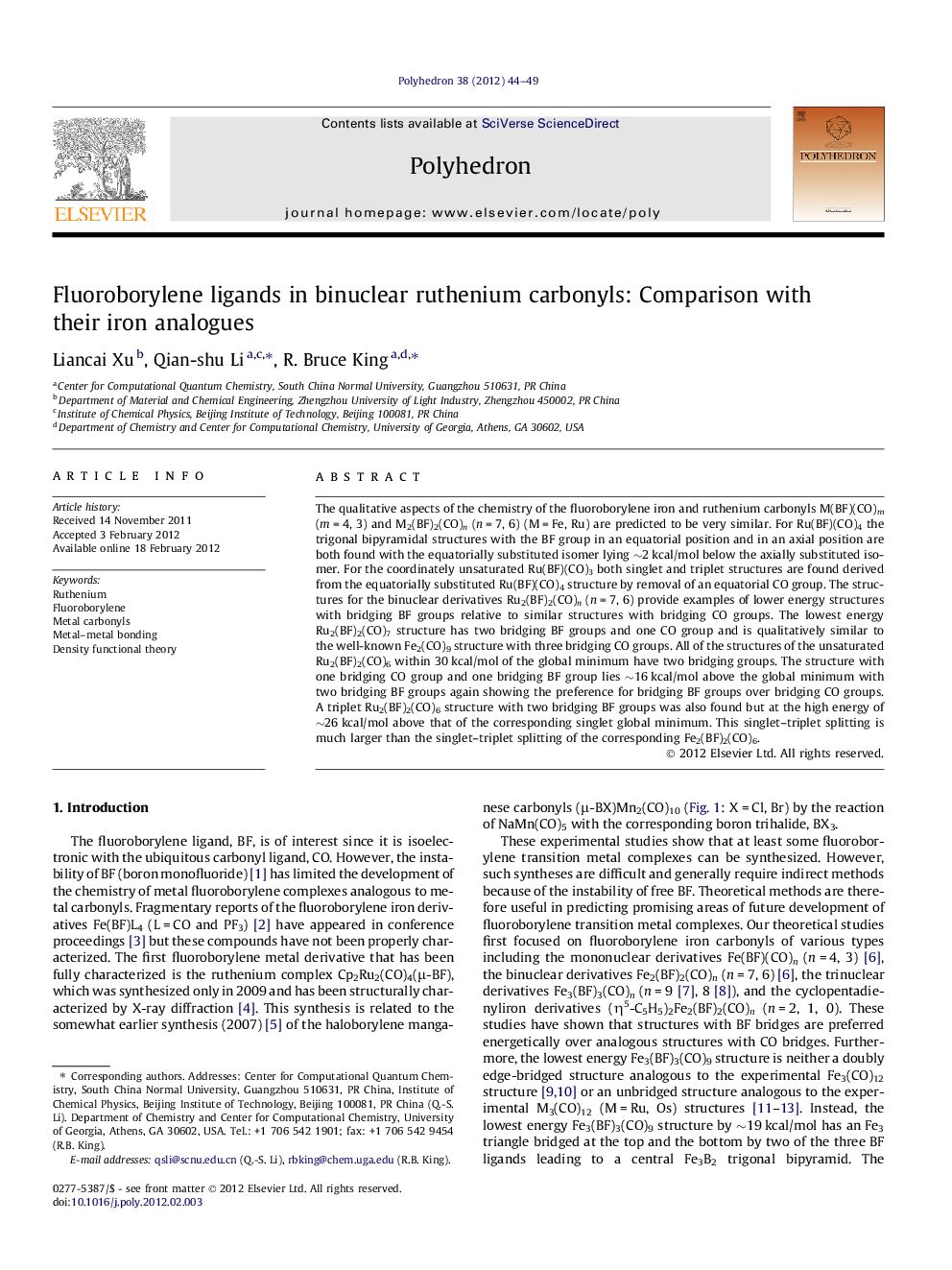| کد مقاله | کد نشریه | سال انتشار | مقاله انگلیسی | نسخه تمام متن |
|---|---|---|---|---|
| 1337656 | 979640 | 2012 | 6 صفحه PDF | دانلود رایگان |

The qualitative aspects of the chemistry of the fluoroborylene iron and ruthenium carbonyls M(BF)(CO)m (m = 4, 3) and M2(BF)2(CO)n (n = 7, 6) (M = Fe, Ru) are predicted to be very similar. For Ru(BF)(CO)4 the trigonal bipyramidal structures with the BF group in an equatorial position and in an axial position are both found with the equatorially substituted isomer lying ∼2 kcal/mol below the axially substituted isomer. For the coordinately unsaturated Ru(BF)(CO)3 both singlet and triplet structures are found derived from the equatorially substituted Ru(BF)(CO)4 structure by removal of an equatorial CO group. The structures for the binuclear derivatives Ru2(BF)2(CO)n (n = 7, 6) provide examples of lower energy structures with bridging BF groups relative to similar structures with bridging CO groups. The lowest energy Ru2(BF)2(CO)7 structure has two bridging BF groups and one CO group and is qualitatively similar to the well-known Fe2(CO)9 structure with three bridging CO groups. All of the structures of the unsaturated Ru2(BF)2(CO)6 within 30 kcal/mol of the global minimum have two bridging groups. The structure with one bridging CO group and one bridging BF group lies ∼16 kcal/mol above the global minimum with two bridging BF groups again showing the preference for bridging BF groups over bridging CO groups. A triplet Ru2(BF)2(CO)6 structure with two bridging BF groups was also found but at the high energy of ∼26 kcal/mol above that of the corresponding singlet global minimum. This singlet–triplet splitting is much larger than the singlet–triplet splitting of the corresponding Fe2(BF)2(CO)6.
The low-energy Ru(BF)(CO)4 structures have RuBC4 trigonal bipyramids with either equatorial or axial BF substitution. The Ru(BF)(CO)3 structures are derived from the equatorially substituted Ru(BF)(CO)4 structure by removal of an equatorial CO group. The Ru2(BF)2(CO)n (n = 7, 6) structures provide examples of structures with bridging BF groups of lower energies relative to similar structures with bridging CO groups. Singlet–triplet splittings are higher in the Ru derivatives than in their Fe analogues.Figure optionsDownload as PowerPoint slideHighlights
► The low-energy Ru(BF)(CO)4 structures have RuBC4 trigonal bipyramids.
► The Ru(BF)(CO)3 structures are derived from Ru(BF)(CO)4 structures by removal of an equatorial CO group.
► The lowest energy Ru2(BF)2(CO)n (n = 7, 6) structures have bridging BF groups.
► Singlet–triplet splittings are higher in the Ru derivatives than in their Fe analogues.
Journal: Polyhedron - Volume 38, Issue 1, 11 May 2012, Pages 44–49